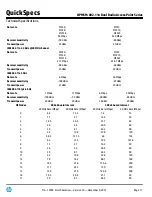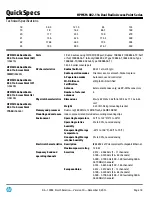
Beamforming
provides better coverage area and better performance at distances from the AP
Bandsteering
redirects 5 GHz-capable clients automatically to the less-congested 5 GHz spectrum
Concurrent operation in the 5 GHz band
provides the ability to run both radios in the 5 GHz band for outstanding performance (MSM466 and MSM466-R access points
only)
MSM430 and MSM 460 AP antennas
embedded high-gain antennas (4 dBi antenna at 2.4 GHz and 7 dBi antenna at 5 GHz) provide excellent coverage without the
added cost of external antennas
MSM466 and MSM466-R access points
Optional external antennas options
MSM466 access point includes six indoor RP-SMA connectors; MSM466-R access point includes six outdoor standard N
connectors
Two indoor ceiling mount antennas
provide good coverage when embedded antennas are not an option
Outdoor IP67-rated antennas
two omnidirectional and two directional MIMO antennas are weatherproof IP67 tested for point-to-point, multipoint,
mesh, and outdoor coverage
Anywhere, anytime wireless coverage
includes dual-radio IEEE 802.11a/b/g/n and 802.11a/n access points; per-radio software-selectable configuration of frequency
bands; self-healing, self-optimizing local mesh that extends network availability; Wi-Fi Alliance Certifications for interoperability
with all IEEE 802.11a/b/g/n client devices; and IEEE 802.3af PoE
Medical standards
meets the European EN60601-1-2 standard for healthcare
Virtual Service Communities (VSCs)
includes up to 16 SSIDs, each with unique MAC address and configurable SSID broadcasts; individual security and QoS profiles
per VSC; configurable DTIM and minimum data rate per VSC; VSCs that can be mapped to separate IEEE 802.1Q VLANs; WMM
and/or WMM-PS; a security filter; and an IP filter
AP client access control functions
offers IEEE 802.1X authentication using EAP-SIM, EAP-FAST, EAP-TLS, EAP-TTLS, and PEAP
delivers MAC address authentication using local or RADIUS access lists
provides RADIUS AAA using EAP-MD5, PAP, CHAP, and MS-CHAPv2
supports RADIUS Client (RFC 2865 and 2866) with location-aware support
provides Layer 2 wireless client isolation
Security
Automated AP and client classification
reduces manual effort (administrator can override AP classification)
Comprehensive detection capabilities
detects a wide range of attacks
Flexible event reporting
enables configuration of which events will result in notifications
Location tracking capabilities
helps identify the location of the rogue device
Flexible deployment models
supports time slicing or dedicating a radio to detect fulltime
IEEE 802.1X support
provides port-based user authentication with support for Extensible Authentication Protocol (EAP) MD5, TLS, TTLS, and PEAP
QuickSpecs
HP MSM-802.11n Dual Radio Access Point Series
Overview
DA - 13994 North America — Version 10 — December 9, 2013
Page 3




































